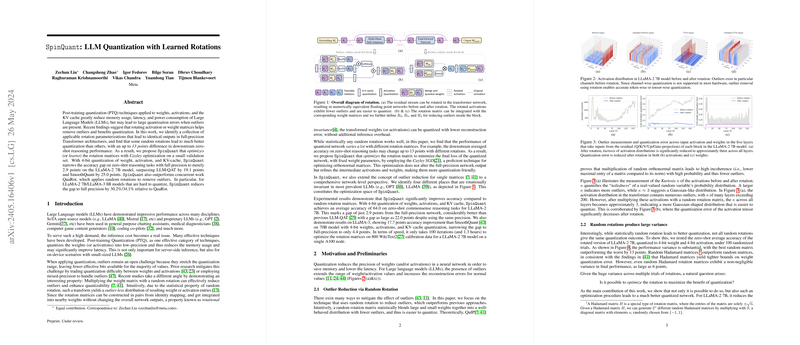SpinQuant: LLM Quantization with Learned Rotations
Introduction
The paper "SpinQuant: LLM Quantization with Learned Rotations" addresses the challenges associated with quantizing LLMs for efficient deployment. Notably, it explores the application of learned rotation matrices in post-training quantization (PTQ) to improve quantization performance while minimizing degradation in reasoning accuracy.
Approach
The conventional quantization process poses challenges due to the presence of outliers that significantly affect the effective quantization range, resulting in increased reconstruction errors. This work posits that such issues can be mitigated through the introduction of statistical rotations to both activations and weights. The authors propose SpinQuant, a method that optimizes rotation matrices using the Cayley Stochastic Gradient Descent (Cayley SGD), a technique specifically designed for optimizing orthonormal matrices.
Numerical Results
Empirically, SpinQuant demonstrates substantial improvements over existing methodologies, including LLM-QAT and SmoothQuant. Specifically, on the LLaMA-2 7B model, the application of SpinQuant reduces the accuracy gap from a full-precision model to merely 2.9 points when using 4-bit quantization for weights, activations, and cache states. This marks a substantial enhancement over previous approaches — surpassing LLM-QAT and QuaRot, with QuaRot noted for integrating random rotations. For larger models like LLaMA-3 70B, SpinQuant also effectively decreases the gap, providing a benefit of 5.0 points over the prevailing state-of-the-art techniques.
Implications and Future Directions
From a theoretical perspective, this research introduces the concept of rotational invariance to the domain of LLM quantization, expanding the optimization space to identify configurations that maintain numerical accuracy while being more conducive to quantization. Practically, this advancement holds the potential to significantly reduce computational overhead associated with inference in server-side applications and small-scale devices alike, given the substantially reduced model footprint enabled by efficient quantization.
Future research could explore understanding the interaction between rotation matrices and specific network layers, refining the optimization process to further exploit architectural characteristics of LLMs. Moreover, as the paper indicates the intriguing possibility of reducing outliers further before applying rotation, exploring source mitigation strategies presents an avenue worth investigating.
Conclusion
In conclusion, SpinQuant emerges as a notable advancement in the quantization of LLMs, combining post-training techniques with learned rotations to bridge the gap between full-precision and low-bit quantized models, thereby providing an effective means to deploy state-of-the-art models with reduced computational and memory resources without sacrificing performance. The application of Cayley optimization to refine rotation matrices underscores its efficacy in balancing performance and resource efficiency, setting a new benchmark for LLM quantization trajectories.
